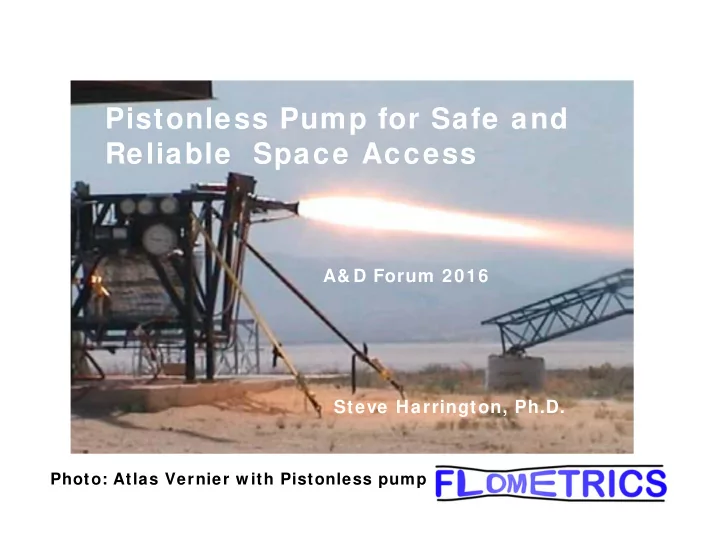

Pistonless Pump for Safe and Reliable Space Access A& D Forum 2016 Steve Harrington, Ph.D. Photo: Atlas Vernier w ith Pistonless pump
Problem: Turbopumps are Unreliable 1 out of 300 orbital launches fail due to turbopump problems. In Oct 2014 the Antares launch failed for this reason. Before that a Proton crashed due to a turbopump bearing in May 2014.
Solution: Pistonless Pump • Performance equivalent to or better than gas generator turbopump systems • Inexpensive materials and processes. Low ers vehicle cost. • Safer: Failure modes are benign, main tank pressures are low er • No precision parts. Inherent reliability. • Robust system; can pass contaminants. • One design w ill w ork w ith many propellants. • 100% Throttleable • Mass producible and scalable • Transition from pressure fed static test to pump fed is simple and quick.
Market: • The launch industry represents $5.9B* of the $203B in global revenue for 2014 of the satellite industry • In 2015 there w ere 82 satellite launches, w ith average cost $72M. Most launchers use turbopumps w hich cost approximately $10M per vehicle, the rocket propellant pump market is $820M Source: ULA •Half of the market are national security missions, not available. •The Pistonless pump sells for 25% of the turbopump w ith good margins • The total addressable market is $100M *Tauri Group 2015 State of the Satellite Industry Report
Go to Market Strategy • Rocket Scientists are risk averse. Pistonless pump must be proven to be considered. • First step is to integrate the Pistonless pump w ith engines of increasing thrust levels to prove scalability. • Next step is integrate and test fly in a small to moderate size vehicle for a reference mission •Sales opportunities happen w hen a new vehicle is on the draw ing board, or w hen an existing vehicle explodes spectacularly due to turbopump problems. Sea Launch 2007
Target Customers • Best customer is not risk averse, has a tight development schedule, and is w ell funded. • Potential applications include: – Scalable rocket pow ered vehicle for DARPA programs – Small thrusters for attitude control and backup propulsion for a vehicle w ith a turbopump main engine. (NASA) – Cyrogenic propellant transfer on orbit w ithout adding heat (DARPA/NASA) – Cubesat Launch vehicles – Space Tourism Vehicles – Scalable Launch Vehicles
Competition • Gas Generator Turbopump 1 st stage has a 2.9% D V penalty, primarily for pump propellant • Pistonless Pump 1 st stage w ith heated liquid Helium pressurant has a 1.3% D V penalty, primarily for pump mass Competitor Product Competitive Analysis Description Expensive Barber- Turbopumps Long Time to Develop Nichols/AJR Long History of Use Various Standard Tank Mass Pressure Fed Cold gas pressurant+tanks System Has been used for flight LLNL Piston Pumps Issues Sealing Under Development Xcor Piston Pumps
How it works: 1. Drain the main tank at low pressure into a pump chamber. 2. Pressurize the pump chamber and feed to the engine. 3. Run two in parallel, venting and filling one faster than the other is emptied. 4. Overlap allow s for steady flow and pressure
Pump Animation 1. Pump starts w ith both chambers full, in thermal equilibrium. 2. One chamber is pressurized, and fuel is delivered until level gets low in that chamber. 3. The pressure is applied to both chambers, and fuel is delivered briefly from both chambers. 4. Then the nearly empty chamber is vented and refilled and the cycle repeats.
Rocket Pump Development SBIR Built pump for NASA Glenn, met all technical milestones, plus demonstrated operation in Zero gee plane. Current DARPA SBIR for 100 & 1000 lbf LOX-Methane Pump For RCS system for Lunar Lander
Student Experiment: Space Urinal Flow Vis Pump test. Flow n on zero gee plane as a secondary experiment run at the Microgravity University at JSC
In tank Design w ith Spherical Chambers for Launch Vehicle
Flometrics Experience • $1M of Pistonless pump based supercomputer liquid cooling systems in production (Chilldyne) • Flow loop for testing hydrazine flow meters • UAV liquid cooling system for Northrop Grumman • Analysis, testing and flying of liquid propellant (LOX/RP) rocket systems. • Pumps, cooling systems, valves, heat exchangers, fluid sprayers and regulators • Patented technology on the market: – Airlife constant positive airw ay pressure device. – Eclipse portable oxygen concentrator – Cymer NanoLith TM 7000 Lithography Light Source – Philips Espirit Medical Ventilator – Scrubbing Bubbles Automatic Toilet Cleaner
Conclusions/ Future Plans • Pump based system w eight and cost are low and it w orks as designed. • Replace turbopumps for spacecraft and launch vehicles at reduced cost w ith increased safety and reliability. • Next steps: – Team up w ith vehicle and engine builders to make launch vehicle and space propulsion systems more safe, reliable and affordable.
Recommend
More recommend